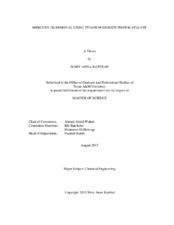| dc.description.abstract | Mercury (Hg) is one of the most detrimental by-products of industrial activities such as fossil fuel combustion and mining. In this study, adsorption and photocatalytic reduction of mercury (II) into elemental mercury using two types of titanium dioxide (TiO2) was investigated.
Photocatalysis involves a material's ability of creating an electron-hole pair after its exposure to solar radiation with photon energy higher than that of the applied photocatalyst, resulting in free-radicals at the positive holes and electrons at the conduction band. These radicals can efficiently reduce or oxidize certain contaminants. Photocatalysis is a convenient method for reducing mercury (II) since it utilizes inexpensive chemicals and solar energy, an energy source found abundantly in Qatar.
Two different types of titanium dioxide were evaluated for Hg(II) removal: commercially available nanoparticles and synthesized nanotubes. The surface properties of the two types of TiO2 were characterized using transmission electron microscopy (TEM), scanning electron microscopy (SEM), X-ray photoelectron spectroscopy (XPS), and X-ray diffraction (XRD). To achieve efficient hole-transfer, formic acid was selected as the hole-scavenger in some of the experiments.
Control experiments were performed in the dark to assess the efficiency of photocatalysis versus direct adsorption. Effects of pH, concentration of hole-scavenger, photocatalyst dose, and irradiation time on Hg(II) removal were evaluated.
Experimental results indicate that more Hg(II) removal occurred at higher pH levels and larger photocatalyst doses. Additionally, the use of formic acid enhanced Hg(II) reduction, indicating that it was an efficient hole scavenger for this application. It was also observed that higher efficiencies were obtained using synthesized nanotubes as compared to commercial nanoparticles.
In the dark, results showed near-to-no adsorption of Hg(II) on the nanoparticles, while a small amount of adsorption occurred in the presence of formic acid. On the other hand, significant amount of Hg(II) was adsorbed on the nanotubes due to their high surface area and increased negative surface charge. Higher removals in the light as compared to dark conditions are clear evidence that photocatalysis is taking place and that TiO2 is an efficient photocatalyst for treating water contaminated with Hg(II). | en |


